HR Report: Developing Individual, Teams and Organizations - Analysis
VerifiedAdded on 2023/03/24
|12
|3760
|72
Report
AI Summary
This report delves into the crucial aspects of Human Resource Management, focusing on the skills, knowledge, and behaviors essential for HR professionals. It begins by outlining the core competencies required in the field, followed by a detailed personal skills audit of a hypothetical individual, Jane Cambridge, assessing her strengths and areas for development. A professional development plan is then constructed for Jane, outlining stages for skill enhancement. The report contrasts organizational and individual learning with training and development methodologies, emphasizing the importance of continuous learning for business sustainability. Further, it explores the role of High-Performance Working in employee engagement and competitive advantage, and provides an overview of performance management approaches. The report provides a comprehensive analysis of HR practices, offering insights into employee development and organizational success.

DEVELOPING
INDIVIDUAL, TEAMS AND
ORGANISATIONS
INDIVIDUAL, TEAMS AND
ORGANISATIONS
Paraphrase This Document
Need a fresh take? Get an instant paraphrase of this document with our AI Paraphraser
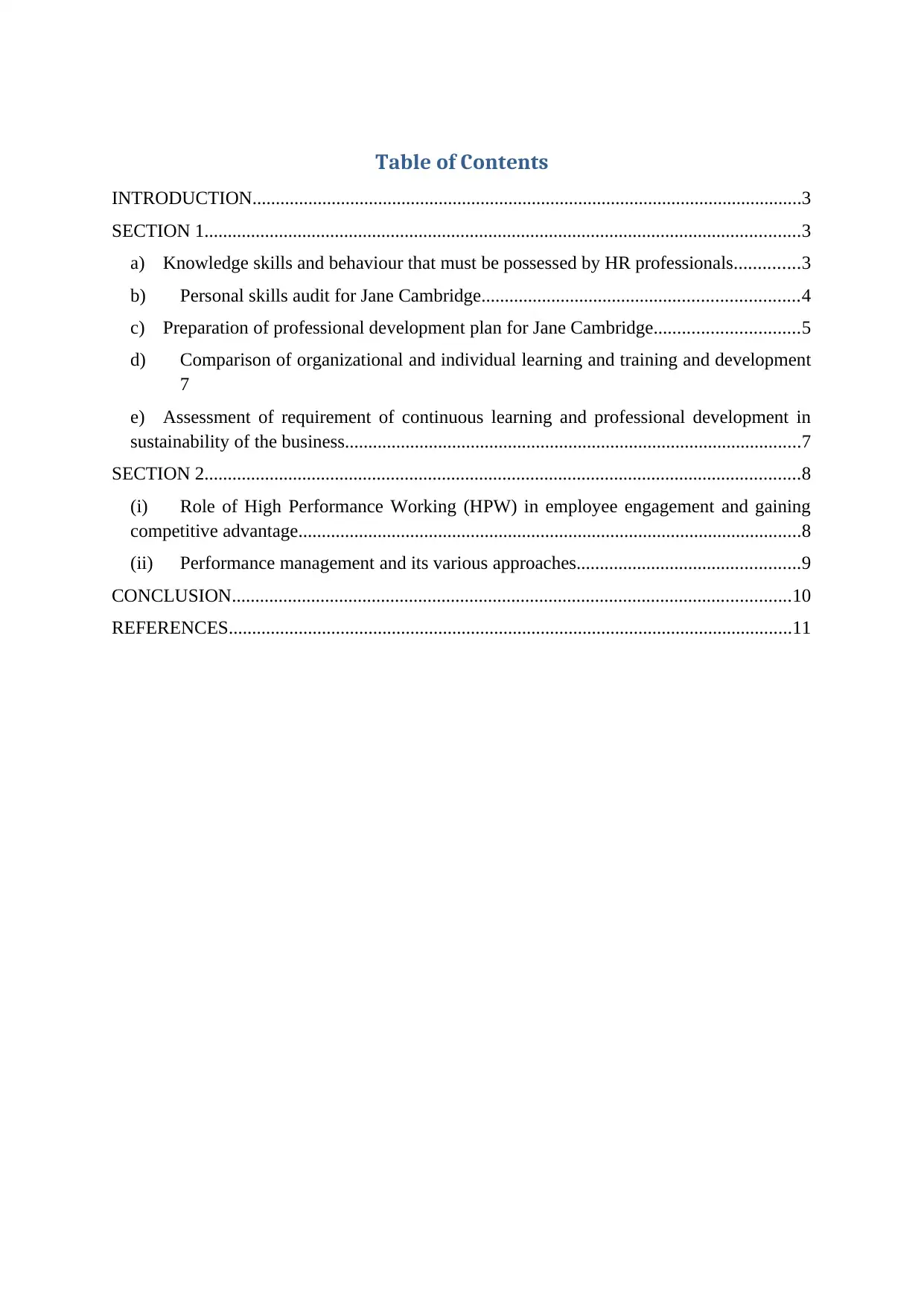
Table of Contents
INTRODUCTION......................................................................................................................3
SECTION 1................................................................................................................................3
a) Knowledge skills and behaviour that must be possessed by HR professionals..............3
b) Personal skills audit for Jane Cambridge....................................................................4
c) Preparation of professional development plan for Jane Cambridge...............................5
d) Comparison of organizational and individual learning and training and development
7
e) Assessment of requirement of continuous learning and professional development in
sustainability of the business..................................................................................................7
SECTION 2................................................................................................................................8
(i) Role of High Performance Working (HPW) in employee engagement and gaining
competitive advantage............................................................................................................8
(ii) Performance management and its various approaches................................................9
CONCLUSION........................................................................................................................10
REFERENCES.........................................................................................................................11
INTRODUCTION......................................................................................................................3
SECTION 1................................................................................................................................3
a) Knowledge skills and behaviour that must be possessed by HR professionals..............3
b) Personal skills audit for Jane Cambridge....................................................................4
c) Preparation of professional development plan for Jane Cambridge...............................5
d) Comparison of organizational and individual learning and training and development
7
e) Assessment of requirement of continuous learning and professional development in
sustainability of the business..................................................................................................7
SECTION 2................................................................................................................................8
(i) Role of High Performance Working (HPW) in employee engagement and gaining
competitive advantage............................................................................................................8
(ii) Performance management and its various approaches................................................9
CONCLUSION........................................................................................................................10
REFERENCES.........................................................................................................................11
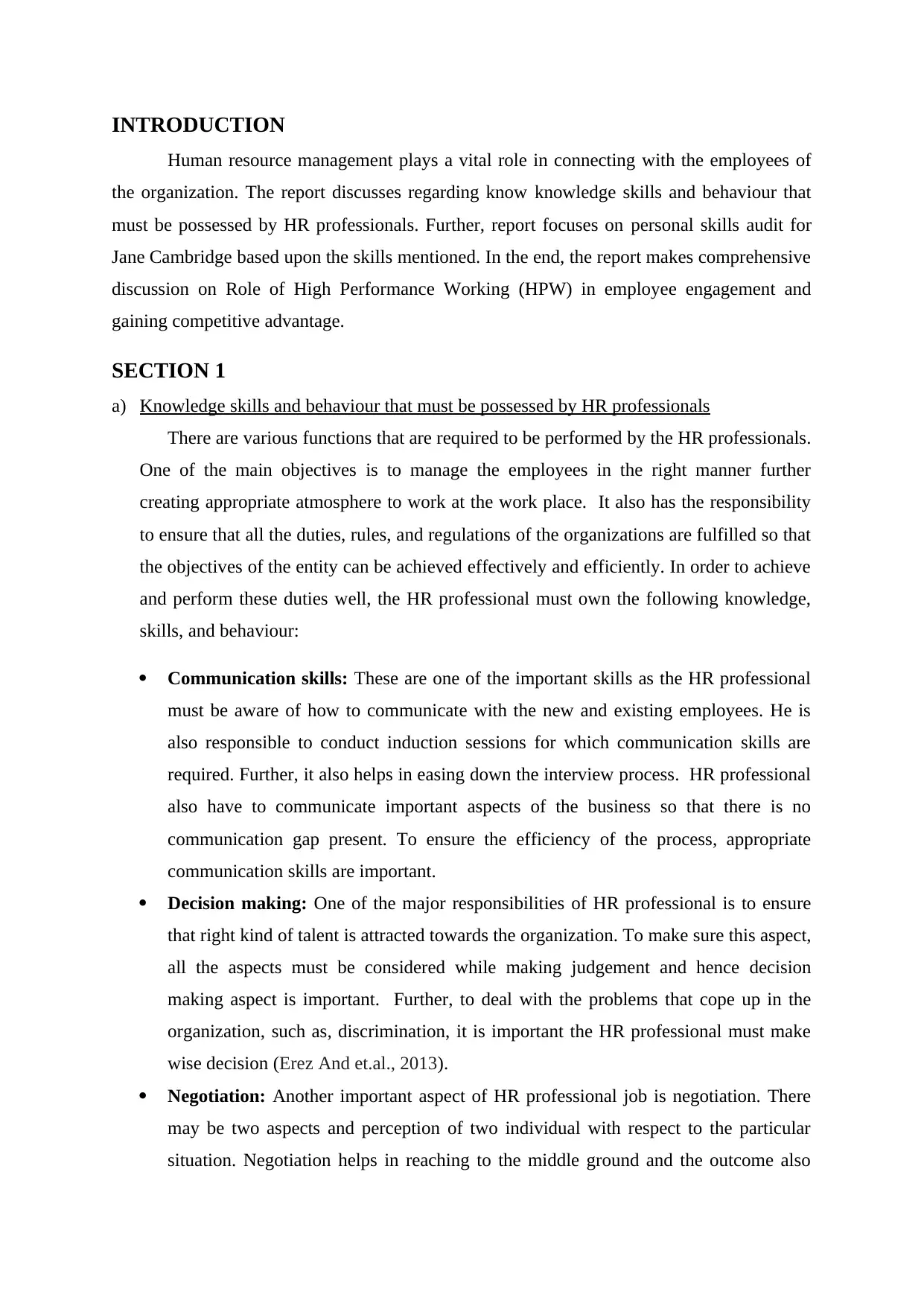
INTRODUCTION
Human resource management plays a vital role in connecting with the employees of
the organization. The report discusses regarding know knowledge skills and behaviour that
must be possessed by HR professionals. Further, report focuses on personal skills audit for
Jane Cambridge based upon the skills mentioned. In the end, the report makes comprehensive
discussion on Role of High Performance Working (HPW) in employee engagement and
gaining competitive advantage.
SECTION 1
a) Knowledge skills and behaviour that must be possessed by HR professionals
There are various functions that are required to be performed by the HR professionals.
One of the main objectives is to manage the employees in the right manner further
creating appropriate atmosphere to work at the work place. It also has the responsibility
to ensure that all the duties, rules, and regulations of the organizations are fulfilled so that
the objectives of the entity can be achieved effectively and efficiently. In order to achieve
and perform these duties well, the HR professional must own the following knowledge,
skills, and behaviour:
Communication skills: These are one of the important skills as the HR professional
must be aware of how to communicate with the new and existing employees. He is
also responsible to conduct induction sessions for which communication skills are
required. Further, it also helps in easing down the interview process. HR professional
also have to communicate important aspects of the business so that there is no
communication gap present. To ensure the efficiency of the process, appropriate
communication skills are important.
Decision making: One of the major responsibilities of HR professional is to ensure
that right kind of talent is attracted towards the organization. To make sure this aspect,
all the aspects must be considered while making judgement and hence decision
making aspect is important. Further, to deal with the problems that cope up in the
organization, such as, discrimination, it is important the HR professional must make
wise decision (Erez And et.al., 2013).
Negotiation: Another important aspect of HR professional job is negotiation. There
may be two aspects and perception of two individual with respect to the particular
situation. Negotiation helps in reaching to the middle ground and the outcome also
Human resource management plays a vital role in connecting with the employees of
the organization. The report discusses regarding know knowledge skills and behaviour that
must be possessed by HR professionals. Further, report focuses on personal skills audit for
Jane Cambridge based upon the skills mentioned. In the end, the report makes comprehensive
discussion on Role of High Performance Working (HPW) in employee engagement and
gaining competitive advantage.
SECTION 1
a) Knowledge skills and behaviour that must be possessed by HR professionals
There are various functions that are required to be performed by the HR professionals.
One of the main objectives is to manage the employees in the right manner further
creating appropriate atmosphere to work at the work place. It also has the responsibility
to ensure that all the duties, rules, and regulations of the organizations are fulfilled so that
the objectives of the entity can be achieved effectively and efficiently. In order to achieve
and perform these duties well, the HR professional must own the following knowledge,
skills, and behaviour:
Communication skills: These are one of the important skills as the HR professional
must be aware of how to communicate with the new and existing employees. He is
also responsible to conduct induction sessions for which communication skills are
required. Further, it also helps in easing down the interview process. HR professional
also have to communicate important aspects of the business so that there is no
communication gap present. To ensure the efficiency of the process, appropriate
communication skills are important.
Decision making: One of the major responsibilities of HR professional is to ensure
that right kind of talent is attracted towards the organization. To make sure this aspect,
all the aspects must be considered while making judgement and hence decision
making aspect is important. Further, to deal with the problems that cope up in the
organization, such as, discrimination, it is important the HR professional must make
wise decision (Erez And et.al., 2013).
Negotiation: Another important aspect of HR professional job is negotiation. There
may be two aspects and perception of two individual with respect to the particular
situation. Negotiation helps in reaching to the middle ground and the outcome also
⊘ This is a preview!⊘
Do you want full access?
Subscribe today to unlock all pages.

Trusted by 1+ million students worldwide
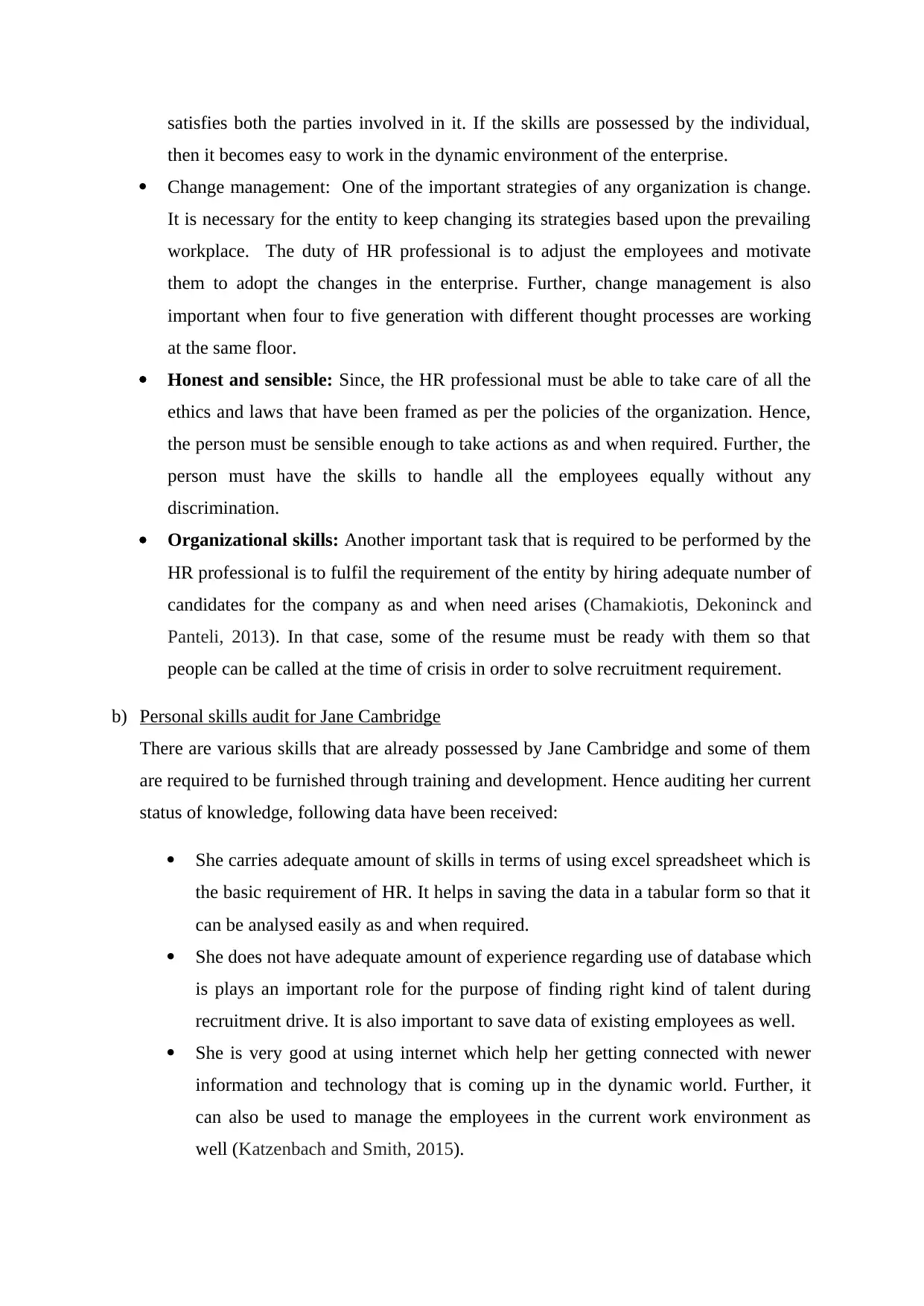
satisfies both the parties involved in it. If the skills are possessed by the individual,
then it becomes easy to work in the dynamic environment of the enterprise.
Change management: One of the important strategies of any organization is change.
It is necessary for the entity to keep changing its strategies based upon the prevailing
workplace. The duty of HR professional is to adjust the employees and motivate
them to adopt the changes in the enterprise. Further, change management is also
important when four to five generation with different thought processes are working
at the same floor.
Honest and sensible: Since, the HR professional must be able to take care of all the
ethics and laws that have been framed as per the policies of the organization. Hence,
the person must be sensible enough to take actions as and when required. Further, the
person must have the skills to handle all the employees equally without any
discrimination.
Organizational skills: Another important task that is required to be performed by the
HR professional is to fulfil the requirement of the entity by hiring adequate number of
candidates for the company as and when need arises (Chamakiotis, Dekoninck and
Panteli, 2013). In that case, some of the resume must be ready with them so that
people can be called at the time of crisis in order to solve recruitment requirement.
b) Personal skills audit for Jane Cambridge
There are various skills that are already possessed by Jane Cambridge and some of them
are required to be furnished through training and development. Hence auditing her current
status of knowledge, following data have been received:
She carries adequate amount of skills in terms of using excel spreadsheet which is
the basic requirement of HR. It helps in saving the data in a tabular form so that it
can be analysed easily as and when required.
She does not have adequate amount of experience regarding use of database which
is plays an important role for the purpose of finding right kind of talent during
recruitment drive. It is also important to save data of existing employees as well.
She is very good at using internet which help her getting connected with newer
information and technology that is coming up in the dynamic world. Further, it
can also be used to manage the employees in the current work environment as
well (Katzenbach and Smith, 2015).
then it becomes easy to work in the dynamic environment of the enterprise.
Change management: One of the important strategies of any organization is change.
It is necessary for the entity to keep changing its strategies based upon the prevailing
workplace. The duty of HR professional is to adjust the employees and motivate
them to adopt the changes in the enterprise. Further, change management is also
important when four to five generation with different thought processes are working
at the same floor.
Honest and sensible: Since, the HR professional must be able to take care of all the
ethics and laws that have been framed as per the policies of the organization. Hence,
the person must be sensible enough to take actions as and when required. Further, the
person must have the skills to handle all the employees equally without any
discrimination.
Organizational skills: Another important task that is required to be performed by the
HR professional is to fulfil the requirement of the entity by hiring adequate number of
candidates for the company as and when need arises (Chamakiotis, Dekoninck and
Panteli, 2013). In that case, some of the resume must be ready with them so that
people can be called at the time of crisis in order to solve recruitment requirement.
b) Personal skills audit for Jane Cambridge
There are various skills that are already possessed by Jane Cambridge and some of them
are required to be furnished through training and development. Hence auditing her current
status of knowledge, following data have been received:
She carries adequate amount of skills in terms of using excel spreadsheet which is
the basic requirement of HR. It helps in saving the data in a tabular form so that it
can be analysed easily as and when required.
She does not have adequate amount of experience regarding use of database which
is plays an important role for the purpose of finding right kind of talent during
recruitment drive. It is also important to save data of existing employees as well.
She is very good at using internet which help her getting connected with newer
information and technology that is coming up in the dynamic world. Further, it
can also be used to manage the employees in the current work environment as
well (Katzenbach and Smith, 2015).
Paraphrase This Document
Need a fresh take? Get an instant paraphrase of this document with our AI Paraphraser
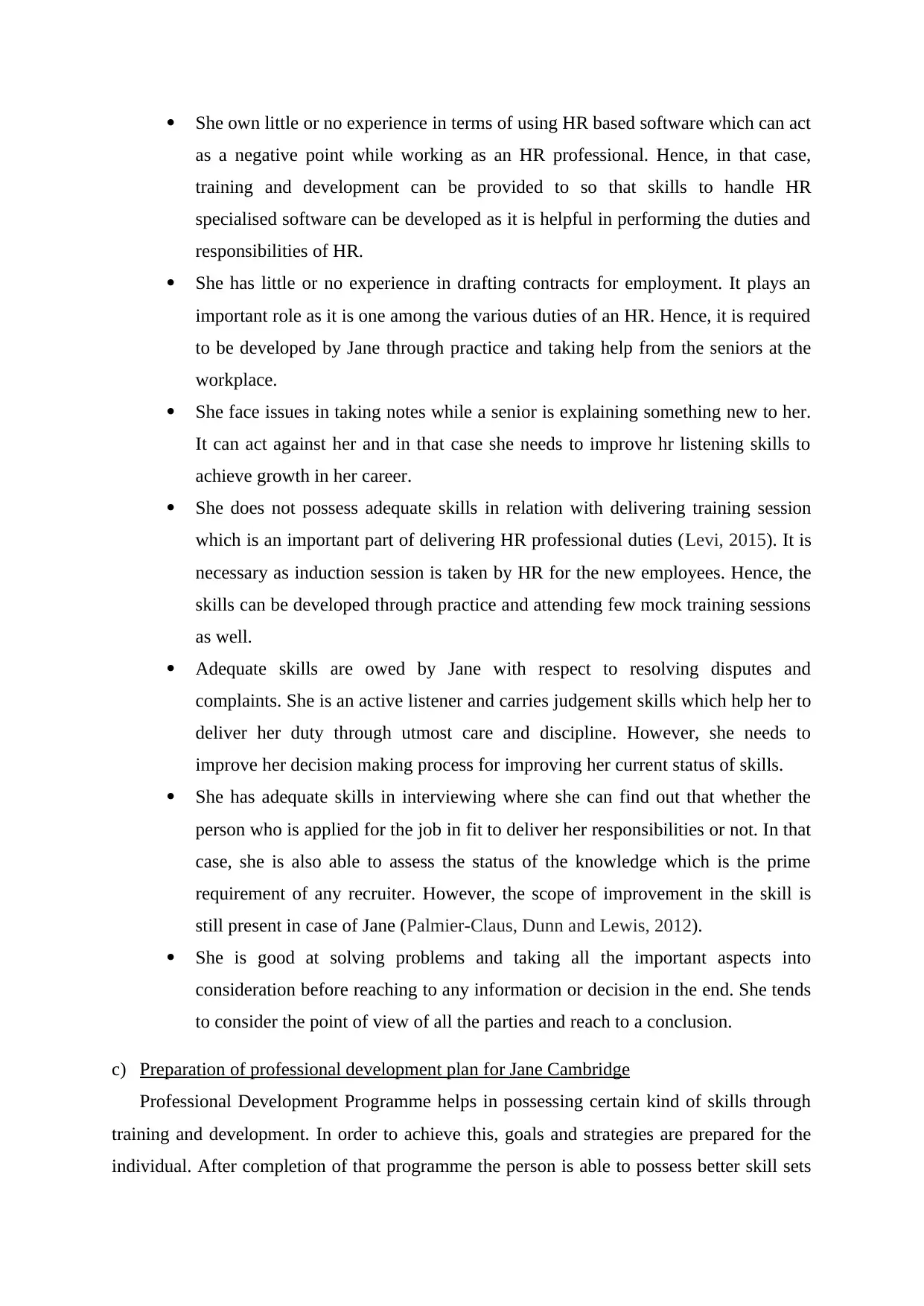
She own little or no experience in terms of using HR based software which can act
as a negative point while working as an HR professional. Hence, in that case,
training and development can be provided to so that skills to handle HR
specialised software can be developed as it is helpful in performing the duties and
responsibilities of HR.
She has little or no experience in drafting contracts for employment. It plays an
important role as it is one among the various duties of an HR. Hence, it is required
to be developed by Jane through practice and taking help from the seniors at the
workplace.
She face issues in taking notes while a senior is explaining something new to her.
It can act against her and in that case she needs to improve hr listening skills to
achieve growth in her career.
She does not possess adequate skills in relation with delivering training session
which is an important part of delivering HR professional duties (Levi, 2015). It is
necessary as induction session is taken by HR for the new employees. Hence, the
skills can be developed through practice and attending few mock training sessions
as well.
Adequate skills are owed by Jane with respect to resolving disputes and
complaints. She is an active listener and carries judgement skills which help her to
deliver her duty through utmost care and discipline. However, she needs to
improve her decision making process for improving her current status of skills.
She has adequate skills in interviewing where she can find out that whether the
person who is applied for the job in fit to deliver her responsibilities or not. In that
case, she is also able to assess the status of the knowledge which is the prime
requirement of any recruiter. However, the scope of improvement in the skill is
still present in case of Jane (Palmier-Claus, Dunn and Lewis, 2012).
She is good at solving problems and taking all the important aspects into
consideration before reaching to any information or decision in the end. She tends
to consider the point of view of all the parties and reach to a conclusion.
c) Preparation of professional development plan for Jane Cambridge
Professional Development Programme helps in possessing certain kind of skills through
training and development. In order to achieve this, goals and strategies are prepared for the
individual. After completion of that programme the person is able to possess better skill sets
as a negative point while working as an HR professional. Hence, in that case,
training and development can be provided to so that skills to handle HR
specialised software can be developed as it is helpful in performing the duties and
responsibilities of HR.
She has little or no experience in drafting contracts for employment. It plays an
important role as it is one among the various duties of an HR. Hence, it is required
to be developed by Jane through practice and taking help from the seniors at the
workplace.
She face issues in taking notes while a senior is explaining something new to her.
It can act against her and in that case she needs to improve hr listening skills to
achieve growth in her career.
She does not possess adequate skills in relation with delivering training session
which is an important part of delivering HR professional duties (Levi, 2015). It is
necessary as induction session is taken by HR for the new employees. Hence, the
skills can be developed through practice and attending few mock training sessions
as well.
Adequate skills are owed by Jane with respect to resolving disputes and
complaints. She is an active listener and carries judgement skills which help her to
deliver her duty through utmost care and discipline. However, she needs to
improve her decision making process for improving her current status of skills.
She has adequate skills in interviewing where she can find out that whether the
person who is applied for the job in fit to deliver her responsibilities or not. In that
case, she is also able to assess the status of the knowledge which is the prime
requirement of any recruiter. However, the scope of improvement in the skill is
still present in case of Jane (Palmier-Claus, Dunn and Lewis, 2012).
She is good at solving problems and taking all the important aspects into
consideration before reaching to any information or decision in the end. She tends
to consider the point of view of all the parties and reach to a conclusion.
c) Preparation of professional development plan for Jane Cambridge
Professional Development Programme helps in possessing certain kind of skills through
training and development. In order to achieve this, goals and strategies are prepared for the
individual. After completion of that programme the person is able to possess better skill sets
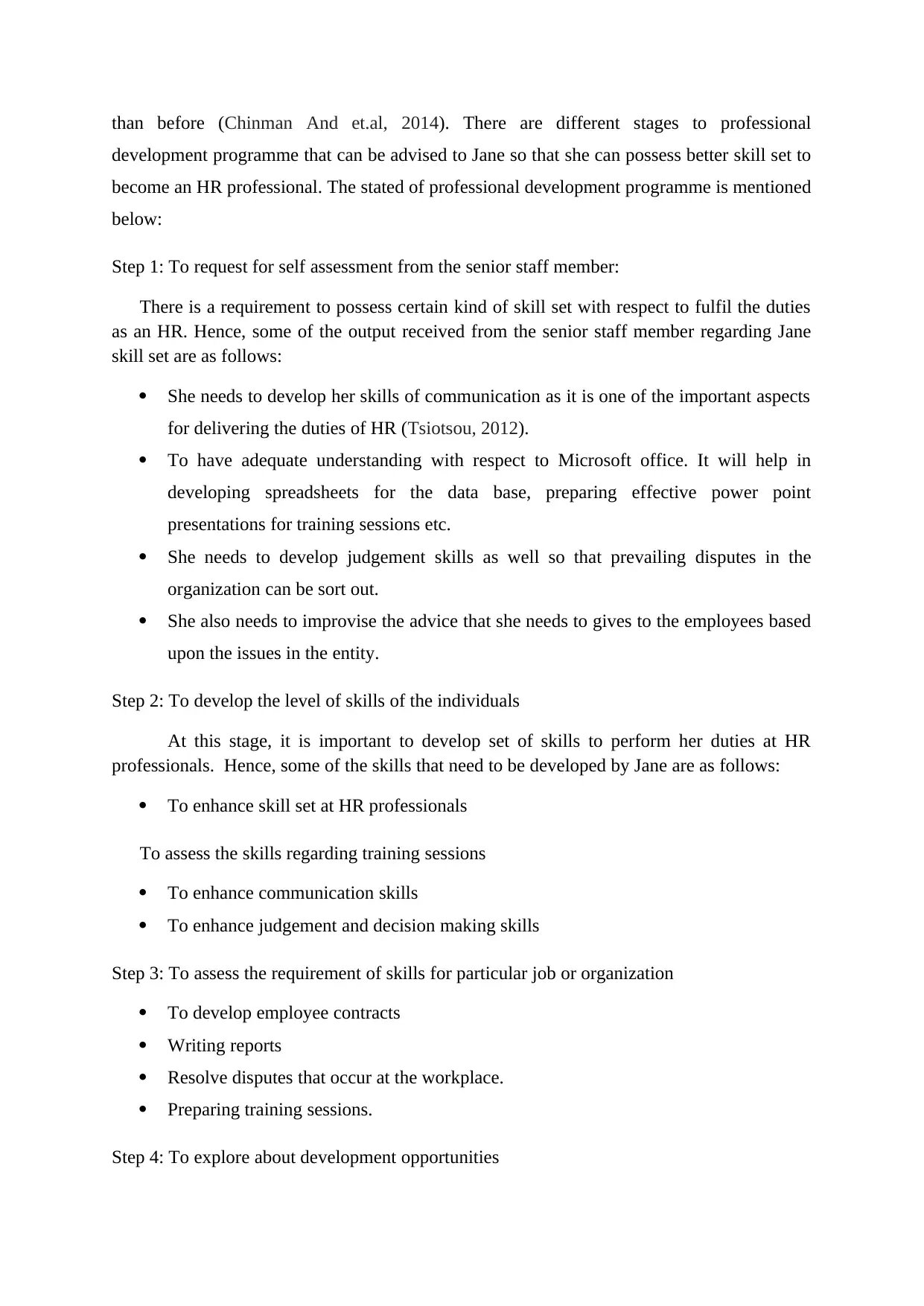
than before (Chinman And et.al, 2014). There are different stages to professional
development programme that can be advised to Jane so that she can possess better skill set to
become an HR professional. The stated of professional development programme is mentioned
below:
Step 1: To request for self assessment from the senior staff member:
There is a requirement to possess certain kind of skill set with respect to fulfil the duties
as an HR. Hence, some of the output received from the senior staff member regarding Jane
skill set are as follows:
She needs to develop her skills of communication as it is one of the important aspects
for delivering the duties of HR (Tsiotsou, 2012).
To have adequate understanding with respect to Microsoft office. It will help in
developing spreadsheets for the data base, preparing effective power point
presentations for training sessions etc.
She needs to develop judgement skills as well so that prevailing disputes in the
organization can be sort out.
She also needs to improvise the advice that she needs to gives to the employees based
upon the issues in the entity.
Step 2: To develop the level of skills of the individuals
At this stage, it is important to develop set of skills to perform her duties at HR
professionals. Hence, some of the skills that need to be developed by Jane are as follows:
To enhance skill set at HR professionals
To assess the skills regarding training sessions
To enhance communication skills
To enhance judgement and decision making skills
Step 3: To assess the requirement of skills for particular job or organization
To develop employee contracts
Writing reports
Resolve disputes that occur at the workplace.
Preparing training sessions.
Step 4: To explore about development opportunities
development programme that can be advised to Jane so that she can possess better skill set to
become an HR professional. The stated of professional development programme is mentioned
below:
Step 1: To request for self assessment from the senior staff member:
There is a requirement to possess certain kind of skill set with respect to fulfil the duties
as an HR. Hence, some of the output received from the senior staff member regarding Jane
skill set are as follows:
She needs to develop her skills of communication as it is one of the important aspects
for delivering the duties of HR (Tsiotsou, 2012).
To have adequate understanding with respect to Microsoft office. It will help in
developing spreadsheets for the data base, preparing effective power point
presentations for training sessions etc.
She needs to develop judgement skills as well so that prevailing disputes in the
organization can be sort out.
She also needs to improvise the advice that she needs to gives to the employees based
upon the issues in the entity.
Step 2: To develop the level of skills of the individuals
At this stage, it is important to develop set of skills to perform her duties at HR
professionals. Hence, some of the skills that need to be developed by Jane are as follows:
To enhance skill set at HR professionals
To assess the skills regarding training sessions
To enhance communication skills
To enhance judgement and decision making skills
Step 3: To assess the requirement of skills for particular job or organization
To develop employee contracts
Writing reports
Resolve disputes that occur at the workplace.
Preparing training sessions.
Step 4: To explore about development opportunities
⊘ This is a preview!⊘
Do you want full access?
Subscribe today to unlock all pages.

Trusted by 1+ million students worldwide
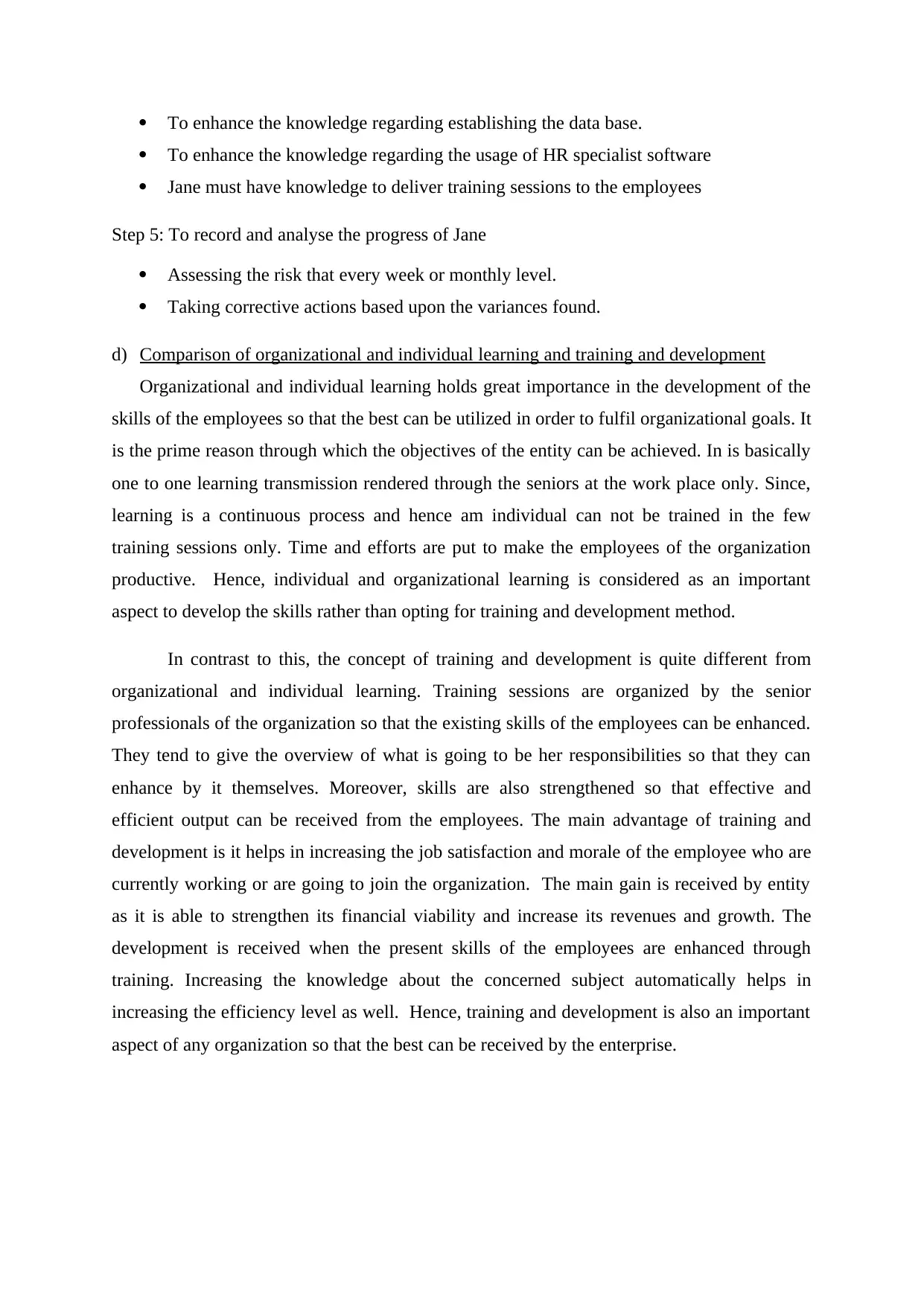
To enhance the knowledge regarding establishing the data base.
To enhance the knowledge regarding the usage of HR specialist software
Jane must have knowledge to deliver training sessions to the employees
Step 5: To record and analyse the progress of Jane
Assessing the risk that every week or monthly level.
Taking corrective actions based upon the variances found.
d) Comparison of organizational and individual learning and training and development
Organizational and individual learning holds great importance in the development of the
skills of the employees so that the best can be utilized in order to fulfil organizational goals. It
is the prime reason through which the objectives of the entity can be achieved. In is basically
one to one learning transmission rendered through the seniors at the work place only. Since,
learning is a continuous process and hence am individual can not be trained in the few
training sessions only. Time and efforts are put to make the employees of the organization
productive. Hence, individual and organizational learning is considered as an important
aspect to develop the skills rather than opting for training and development method.
In contrast to this, the concept of training and development is quite different from
organizational and individual learning. Training sessions are organized by the senior
professionals of the organization so that the existing skills of the employees can be enhanced.
They tend to give the overview of what is going to be her responsibilities so that they can
enhance by it themselves. Moreover, skills are also strengthened so that effective and
efficient output can be received from the employees. The main advantage of training and
development is it helps in increasing the job satisfaction and morale of the employee who are
currently working or are going to join the organization. The main gain is received by entity
as it is able to strengthen its financial viability and increase its revenues and growth. The
development is received when the present skills of the employees are enhanced through
training. Increasing the knowledge about the concerned subject automatically helps in
increasing the efficiency level as well. Hence, training and development is also an important
aspect of any organization so that the best can be received by the enterprise.
To enhance the knowledge regarding the usage of HR specialist software
Jane must have knowledge to deliver training sessions to the employees
Step 5: To record and analyse the progress of Jane
Assessing the risk that every week or monthly level.
Taking corrective actions based upon the variances found.
d) Comparison of organizational and individual learning and training and development
Organizational and individual learning holds great importance in the development of the
skills of the employees so that the best can be utilized in order to fulfil organizational goals. It
is the prime reason through which the objectives of the entity can be achieved. In is basically
one to one learning transmission rendered through the seniors at the work place only. Since,
learning is a continuous process and hence am individual can not be trained in the few
training sessions only. Time and efforts are put to make the employees of the organization
productive. Hence, individual and organizational learning is considered as an important
aspect to develop the skills rather than opting for training and development method.
In contrast to this, the concept of training and development is quite different from
organizational and individual learning. Training sessions are organized by the senior
professionals of the organization so that the existing skills of the employees can be enhanced.
They tend to give the overview of what is going to be her responsibilities so that they can
enhance by it themselves. Moreover, skills are also strengthened so that effective and
efficient output can be received from the employees. The main advantage of training and
development is it helps in increasing the job satisfaction and morale of the employee who are
currently working or are going to join the organization. The main gain is received by entity
as it is able to strengthen its financial viability and increase its revenues and growth. The
development is received when the present skills of the employees are enhanced through
training. Increasing the knowledge about the concerned subject automatically helps in
increasing the efficiency level as well. Hence, training and development is also an important
aspect of any organization so that the best can be received by the enterprise.
Paraphrase This Document
Need a fresh take? Get an instant paraphrase of this document with our AI Paraphraser
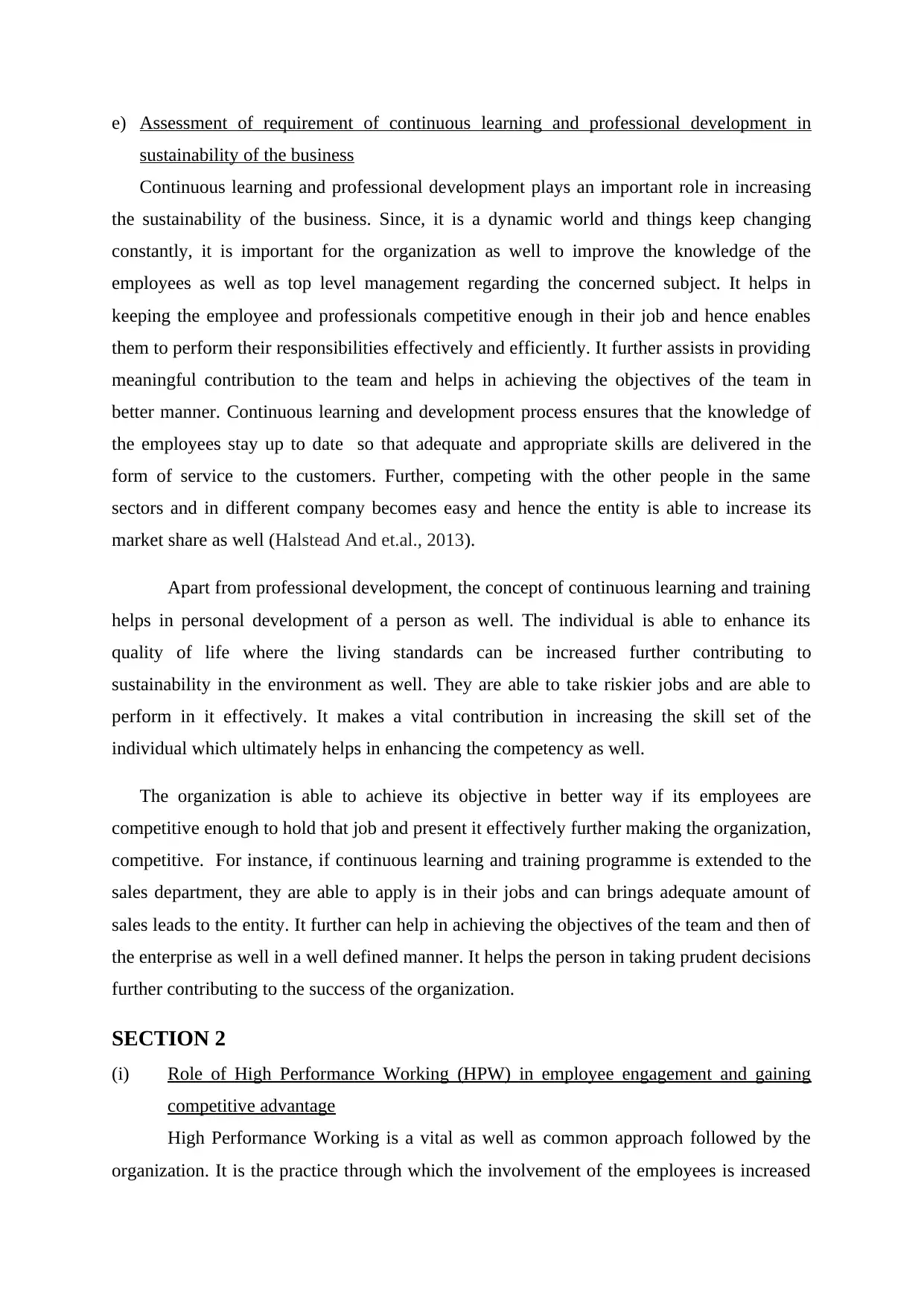
e) Assessment of requirement of continuous learning and professional development in
sustainability of the business
Continuous learning and professional development plays an important role in increasing
the sustainability of the business. Since, it is a dynamic world and things keep changing
constantly, it is important for the organization as well to improve the knowledge of the
employees as well as top level management regarding the concerned subject. It helps in
keeping the employee and professionals competitive enough in their job and hence enables
them to perform their responsibilities effectively and efficiently. It further assists in providing
meaningful contribution to the team and helps in achieving the objectives of the team in
better manner. Continuous learning and development process ensures that the knowledge of
the employees stay up to date so that adequate and appropriate skills are delivered in the
form of service to the customers. Further, competing with the other people in the same
sectors and in different company becomes easy and hence the entity is able to increase its
market share as well (Halstead And et.al., 2013).
Apart from professional development, the concept of continuous learning and training
helps in personal development of a person as well. The individual is able to enhance its
quality of life where the living standards can be increased further contributing to
sustainability in the environment as well. They are able to take riskier jobs and are able to
perform in it effectively. It makes a vital contribution in increasing the skill set of the
individual which ultimately helps in enhancing the competency as well.
The organization is able to achieve its objective in better way if its employees are
competitive enough to hold that job and present it effectively further making the organization,
competitive. For instance, if continuous learning and training programme is extended to the
sales department, they are able to apply is in their jobs and can brings adequate amount of
sales leads to the entity. It further can help in achieving the objectives of the team and then of
the enterprise as well in a well defined manner. It helps the person in taking prudent decisions
further contributing to the success of the organization.
SECTION 2
(i) Role of High Performance Working (HPW) in employee engagement and gaining
competitive advantage
High Performance Working is a vital as well as common approach followed by the
organization. It is the practice through which the involvement of the employees is increased
sustainability of the business
Continuous learning and professional development plays an important role in increasing
the sustainability of the business. Since, it is a dynamic world and things keep changing
constantly, it is important for the organization as well to improve the knowledge of the
employees as well as top level management regarding the concerned subject. It helps in
keeping the employee and professionals competitive enough in their job and hence enables
them to perform their responsibilities effectively and efficiently. It further assists in providing
meaningful contribution to the team and helps in achieving the objectives of the team in
better manner. Continuous learning and development process ensures that the knowledge of
the employees stay up to date so that adequate and appropriate skills are delivered in the
form of service to the customers. Further, competing with the other people in the same
sectors and in different company becomes easy and hence the entity is able to increase its
market share as well (Halstead And et.al., 2013).
Apart from professional development, the concept of continuous learning and training
helps in personal development of a person as well. The individual is able to enhance its
quality of life where the living standards can be increased further contributing to
sustainability in the environment as well. They are able to take riskier jobs and are able to
perform in it effectively. It makes a vital contribution in increasing the skill set of the
individual which ultimately helps in enhancing the competency as well.
The organization is able to achieve its objective in better way if its employees are
competitive enough to hold that job and present it effectively further making the organization,
competitive. For instance, if continuous learning and training programme is extended to the
sales department, they are able to apply is in their jobs and can brings adequate amount of
sales leads to the entity. It further can help in achieving the objectives of the team and then of
the enterprise as well in a well defined manner. It helps the person in taking prudent decisions
further contributing to the success of the organization.
SECTION 2
(i) Role of High Performance Working (HPW) in employee engagement and gaining
competitive advantage
High Performance Working is a vital as well as common approach followed by the
organization. It is the practice through which the involvement of the employees is increased
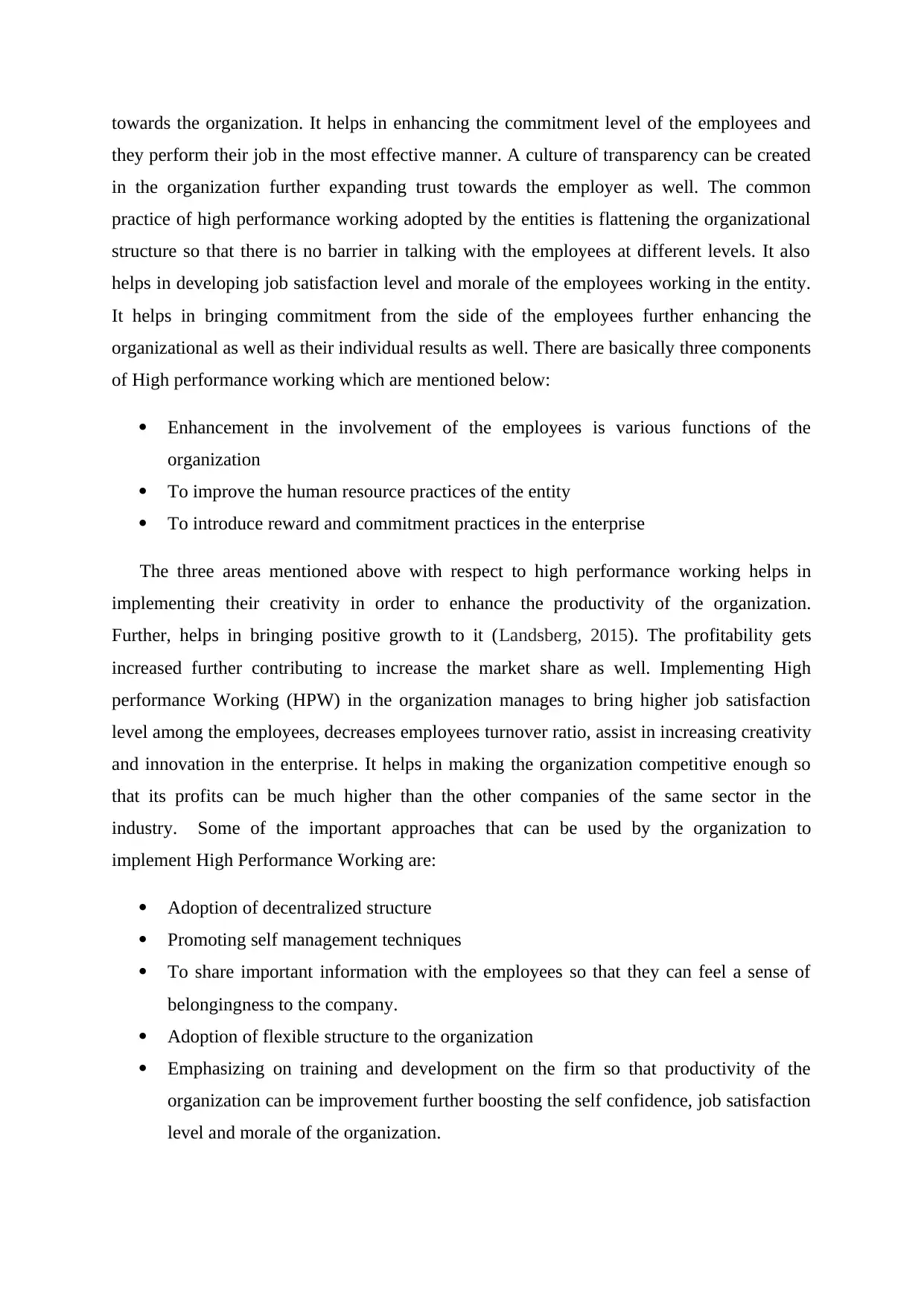
towards the organization. It helps in enhancing the commitment level of the employees and
they perform their job in the most effective manner. A culture of transparency can be created
in the organization further expanding trust towards the employer as well. The common
practice of high performance working adopted by the entities is flattening the organizational
structure so that there is no barrier in talking with the employees at different levels. It also
helps in developing job satisfaction level and morale of the employees working in the entity.
It helps in bringing commitment from the side of the employees further enhancing the
organizational as well as their individual results as well. There are basically three components
of High performance working which are mentioned below:
Enhancement in the involvement of the employees is various functions of the
organization
To improve the human resource practices of the entity
To introduce reward and commitment practices in the enterprise
The three areas mentioned above with respect to high performance working helps in
implementing their creativity in order to enhance the productivity of the organization.
Further, helps in bringing positive growth to it (Landsberg, 2015). The profitability gets
increased further contributing to increase the market share as well. Implementing High
performance Working (HPW) in the organization manages to bring higher job satisfaction
level among the employees, decreases employees turnover ratio, assist in increasing creativity
and innovation in the enterprise. It helps in making the organization competitive enough so
that its profits can be much higher than the other companies of the same sector in the
industry. Some of the important approaches that can be used by the organization to
implement High Performance Working are:
Adoption of decentralized structure
Promoting self management techniques
To share important information with the employees so that they can feel a sense of
belongingness to the company.
Adoption of flexible structure to the organization
Emphasizing on training and development on the firm so that productivity of the
organization can be improvement further boosting the self confidence, job satisfaction
level and morale of the organization.
they perform their job in the most effective manner. A culture of transparency can be created
in the organization further expanding trust towards the employer as well. The common
practice of high performance working adopted by the entities is flattening the organizational
structure so that there is no barrier in talking with the employees at different levels. It also
helps in developing job satisfaction level and morale of the employees working in the entity.
It helps in bringing commitment from the side of the employees further enhancing the
organizational as well as their individual results as well. There are basically three components
of High performance working which are mentioned below:
Enhancement in the involvement of the employees is various functions of the
organization
To improve the human resource practices of the entity
To introduce reward and commitment practices in the enterprise
The three areas mentioned above with respect to high performance working helps in
implementing their creativity in order to enhance the productivity of the organization.
Further, helps in bringing positive growth to it (Landsberg, 2015). The profitability gets
increased further contributing to increase the market share as well. Implementing High
performance Working (HPW) in the organization manages to bring higher job satisfaction
level among the employees, decreases employees turnover ratio, assist in increasing creativity
and innovation in the enterprise. It helps in making the organization competitive enough so
that its profits can be much higher than the other companies of the same sector in the
industry. Some of the important approaches that can be used by the organization to
implement High Performance Working are:
Adoption of decentralized structure
Promoting self management techniques
To share important information with the employees so that they can feel a sense of
belongingness to the company.
Adoption of flexible structure to the organization
Emphasizing on training and development on the firm so that productivity of the
organization can be improvement further boosting the self confidence, job satisfaction
level and morale of the organization.
⊘ This is a preview!⊘
Do you want full access?
Subscribe today to unlock all pages.

Trusted by 1+ million students worldwide

(ii) Performance management and its various approaches
Performance management is the important aspect of the company as it helps in
assessing that what all the employee are productive enough and who are the people which
require adequate amount of training and development sessions. Some of the common
approaches to performance management are as follows:
Comparative approach: The rank is given to the employees based upon their
performance in the previous month or quarter. They are arranged from the lowest to
the highest rank defining their performance. The company provides training and
development to the people who stand at lower level. Further, problems that are related
to their rank is also analysed based on which the top management rake corrective
actions. It helps in improving their performance further maintains to reach at High
performance working level as well.
Behavioural approach: Another important approach in behavioural approach where
based on the positive or negative attitude towards work, employees are ranked. The
most common approach used by the entities is Behaviourally Anchored Rating Scale
(BARS). It acts as a guide which can be followed by the companies to assess the
behaviour of the employees (Serrat, 2017). Every aspect of the performer is judged
based on their behaviour. It helps in inculcating right type of behaviour in the
employees further contributing to high performance behaviour.
Results approach: It helps in measuring the performance of the employees based on
the results. It is assessed on the basis that whether the goals are achieved or not. It is
in the black or white format. Achievement of strategic goals helps in motivating the
employees to achieve their goals. It helps in driving the company towards high
performance working.
Quality approach: As per this approach, it helps in providing the best to the
employees. It helps in achieving the maximum customer level to ensure high
performance working (Effective performance management: five approaches defined,
2017). Non defected material acts as a motivating factor for the growth of
organization for both employees and top level management.
CONCLUSION
Based on the above report, it can be concluded that, employees’ satisfaction act as a
motivating factors for them and for the organization as well. Human resource professional
must possess adequate amount of skills in order to conduct the responsibilities in best
Performance management is the important aspect of the company as it helps in
assessing that what all the employee are productive enough and who are the people which
require adequate amount of training and development sessions. Some of the common
approaches to performance management are as follows:
Comparative approach: The rank is given to the employees based upon their
performance in the previous month or quarter. They are arranged from the lowest to
the highest rank defining their performance. The company provides training and
development to the people who stand at lower level. Further, problems that are related
to their rank is also analysed based on which the top management rake corrective
actions. It helps in improving their performance further maintains to reach at High
performance working level as well.
Behavioural approach: Another important approach in behavioural approach where
based on the positive or negative attitude towards work, employees are ranked. The
most common approach used by the entities is Behaviourally Anchored Rating Scale
(BARS). It acts as a guide which can be followed by the companies to assess the
behaviour of the employees (Serrat, 2017). Every aspect of the performer is judged
based on their behaviour. It helps in inculcating right type of behaviour in the
employees further contributing to high performance behaviour.
Results approach: It helps in measuring the performance of the employees based on
the results. It is assessed on the basis that whether the goals are achieved or not. It is
in the black or white format. Achievement of strategic goals helps in motivating the
employees to achieve their goals. It helps in driving the company towards high
performance working.
Quality approach: As per this approach, it helps in providing the best to the
employees. It helps in achieving the maximum customer level to ensure high
performance working (Effective performance management: five approaches defined,
2017). Non defected material acts as a motivating factor for the growth of
organization for both employees and top level management.
CONCLUSION
Based on the above report, it can be concluded that, employees’ satisfaction act as a
motivating factors for them and for the organization as well. Human resource professional
must possess adequate amount of skills in order to conduct the responsibilities in best
Paraphrase This Document
Need a fresh take? Get an instant paraphrase of this document with our AI Paraphraser
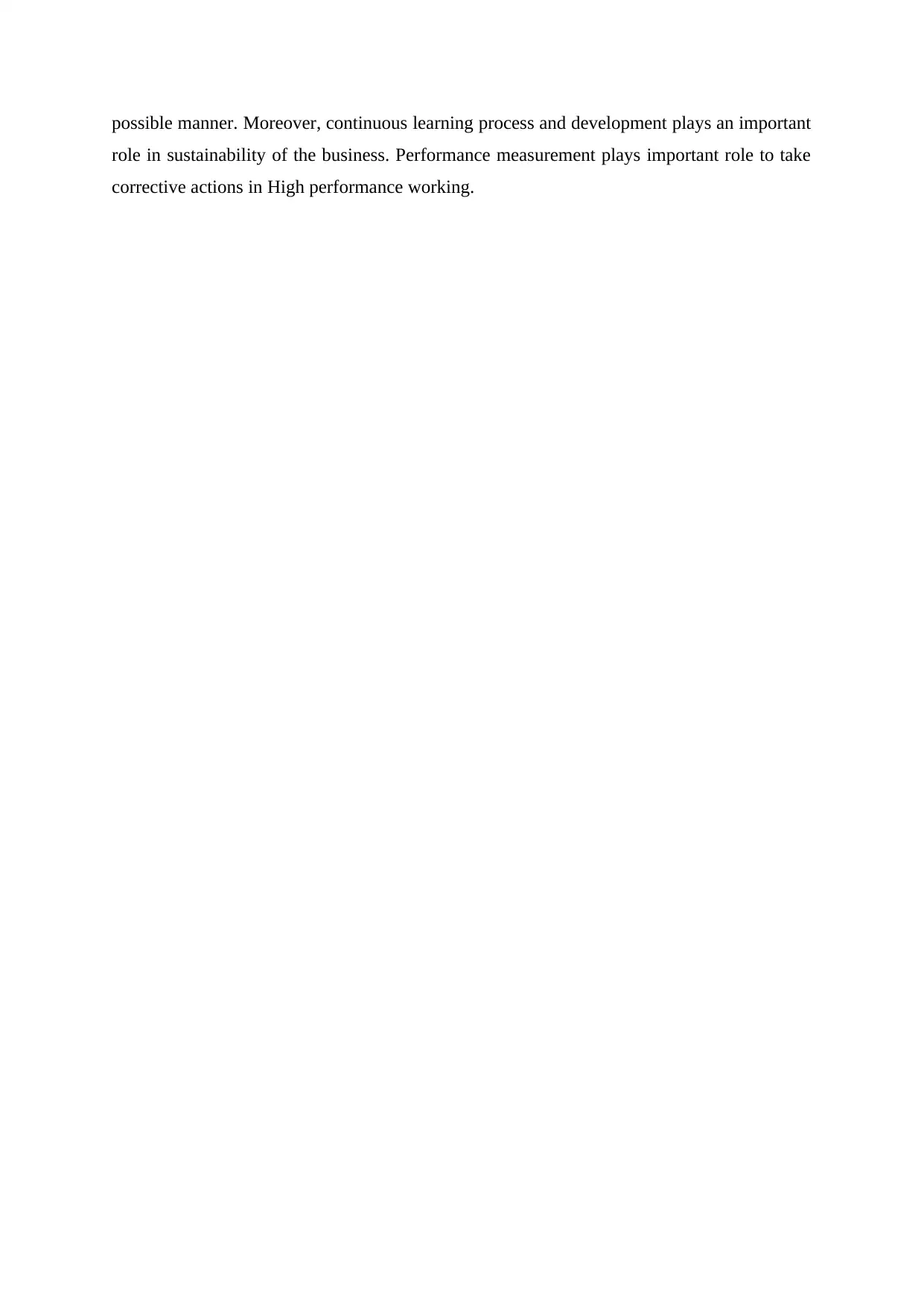
possible manner. Moreover, continuous learning process and development plays an important
role in sustainability of the business. Performance measurement plays important role to take
corrective actions in High performance working.
role in sustainability of the business. Performance measurement plays important role to take
corrective actions in High performance working.
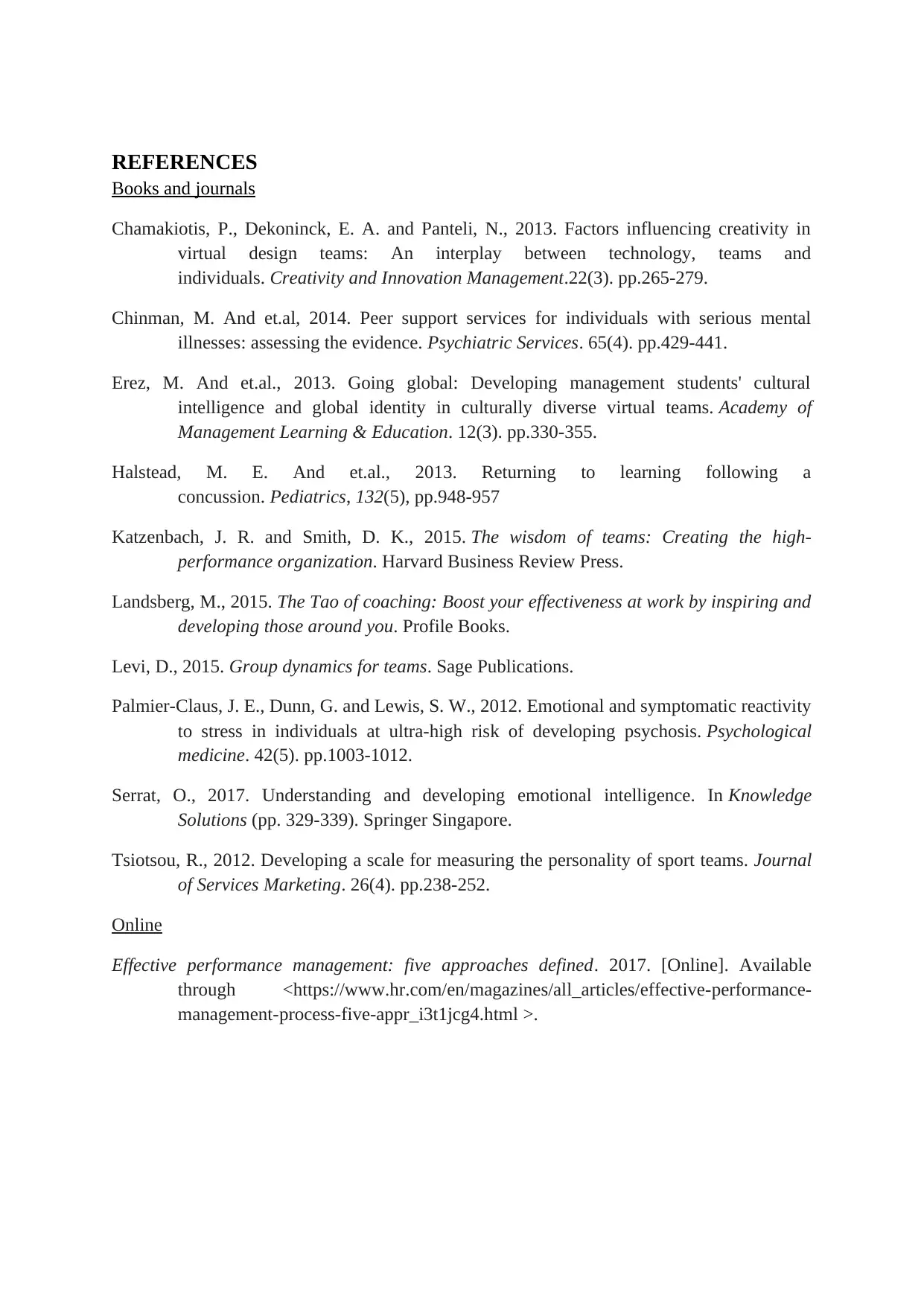
REFERENCES
Books and journals
Chamakiotis, P., Dekoninck, E. A. and Panteli, N., 2013. Factors influencing creativity in
virtual design teams: An interplay between technology, teams and
individuals. Creativity and Innovation Management.22(3). pp.265-279.
Chinman, M. And et.al, 2014. Peer support services for individuals with serious mental
illnesses: assessing the evidence. Psychiatric Services. 65(4). pp.429-441.
Erez, M. And et.al., 2013. Going global: Developing management students' cultural
intelligence and global identity in culturally diverse virtual teams. Academy of
Management Learning & Education. 12(3). pp.330-355.
Halstead, M. E. And et.al., 2013. Returning to learning following a
concussion. Pediatrics, 132(5), pp.948-957
Katzenbach, J. R. and Smith, D. K., 2015. The wisdom of teams: Creating the high-
performance organization. Harvard Business Review Press.
Landsberg, M., 2015. The Tao of coaching: Boost your effectiveness at work by inspiring and
developing those around you. Profile Books.
Levi, D., 2015. Group dynamics for teams. Sage Publications.
Palmier-Claus, J. E., Dunn, G. and Lewis, S. W., 2012. Emotional and symptomatic reactivity
to stress in individuals at ultra-high risk of developing psychosis. Psychological
medicine. 42(5). pp.1003-1012.
Serrat, O., 2017. Understanding and developing emotional intelligence. In Knowledge
Solutions (pp. 329-339). Springer Singapore.
Tsiotsou, R., 2012. Developing a scale for measuring the personality of sport teams. Journal
of Services Marketing. 26(4). pp.238-252.
Online
Effective performance management: five approaches defined. 2017. [Online]. Available
through <https://www.hr.com/en/magazines/all_articles/effective-performance-
management-process-five-appr_i3t1jcg4.html >.
Books and journals
Chamakiotis, P., Dekoninck, E. A. and Panteli, N., 2013. Factors influencing creativity in
virtual design teams: An interplay between technology, teams and
individuals. Creativity and Innovation Management.22(3). pp.265-279.
Chinman, M. And et.al, 2014. Peer support services for individuals with serious mental
illnesses: assessing the evidence. Psychiatric Services. 65(4). pp.429-441.
Erez, M. And et.al., 2013. Going global: Developing management students' cultural
intelligence and global identity in culturally diverse virtual teams. Academy of
Management Learning & Education. 12(3). pp.330-355.
Halstead, M. E. And et.al., 2013. Returning to learning following a
concussion. Pediatrics, 132(5), pp.948-957
Katzenbach, J. R. and Smith, D. K., 2015. The wisdom of teams: Creating the high-
performance organization. Harvard Business Review Press.
Landsberg, M., 2015. The Tao of coaching: Boost your effectiveness at work by inspiring and
developing those around you. Profile Books.
Levi, D., 2015. Group dynamics for teams. Sage Publications.
Palmier-Claus, J. E., Dunn, G. and Lewis, S. W., 2012. Emotional and symptomatic reactivity
to stress in individuals at ultra-high risk of developing psychosis. Psychological
medicine. 42(5). pp.1003-1012.
Serrat, O., 2017. Understanding and developing emotional intelligence. In Knowledge
Solutions (pp. 329-339). Springer Singapore.
Tsiotsou, R., 2012. Developing a scale for measuring the personality of sport teams. Journal
of Services Marketing. 26(4). pp.238-252.
Online
Effective performance management: five approaches defined. 2017. [Online]. Available
through <https://www.hr.com/en/magazines/all_articles/effective-performance-
management-process-five-appr_i3t1jcg4.html >.
⊘ This is a preview!⊘
Do you want full access?
Subscribe today to unlock all pages.

Trusted by 1+ million students worldwide
1 out of 12
Related Documents
Your All-in-One AI-Powered Toolkit for Academic Success.
+13062052269
info@desklib.com
Available 24*7 on WhatsApp / Email
![[object Object]](/_next/static/media/star-bottom.7253800d.svg)
Unlock your academic potential
Copyright © 2020–2025 A2Z Services. All Rights Reserved. Developed and managed by ZUCOL.





